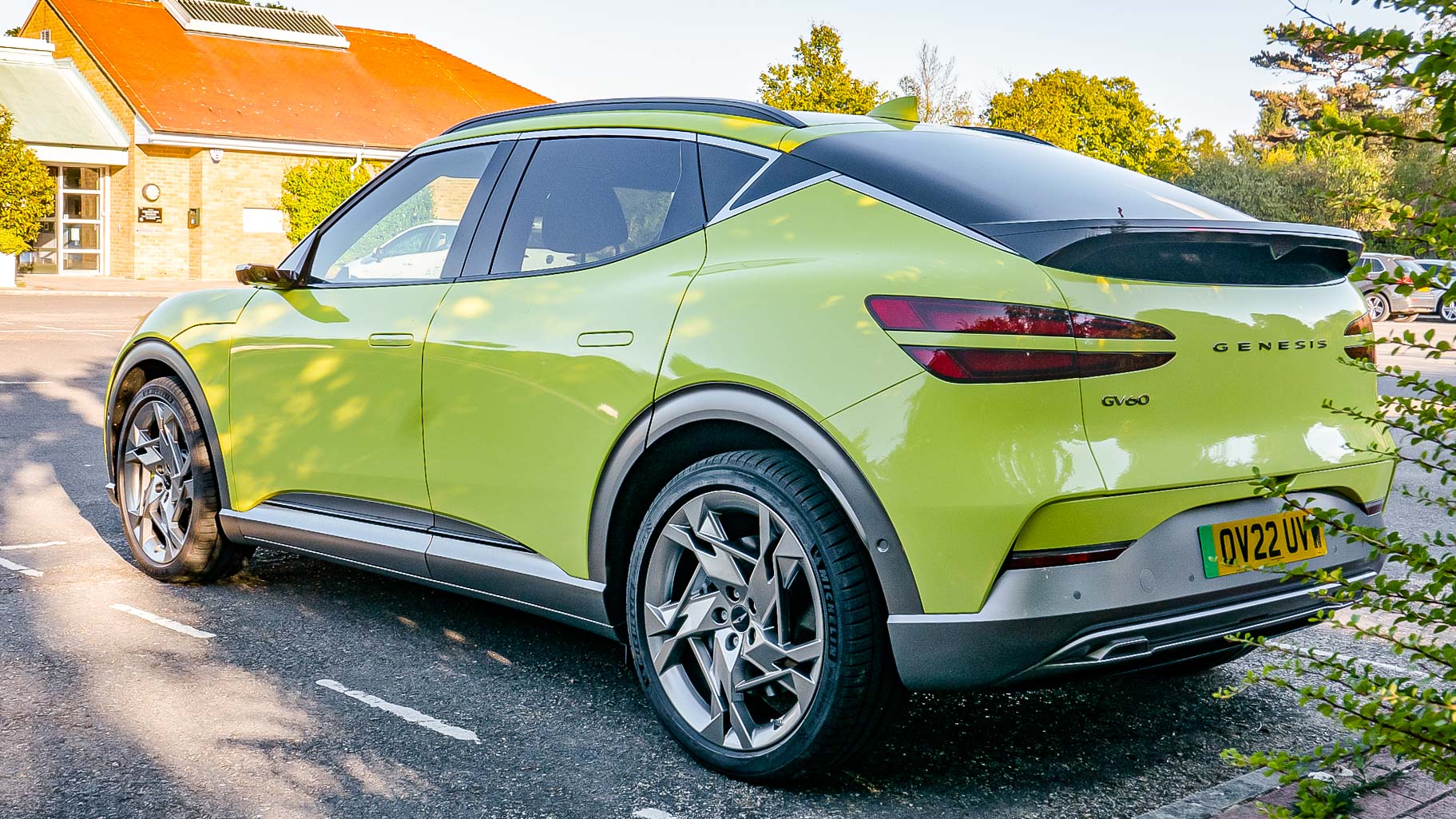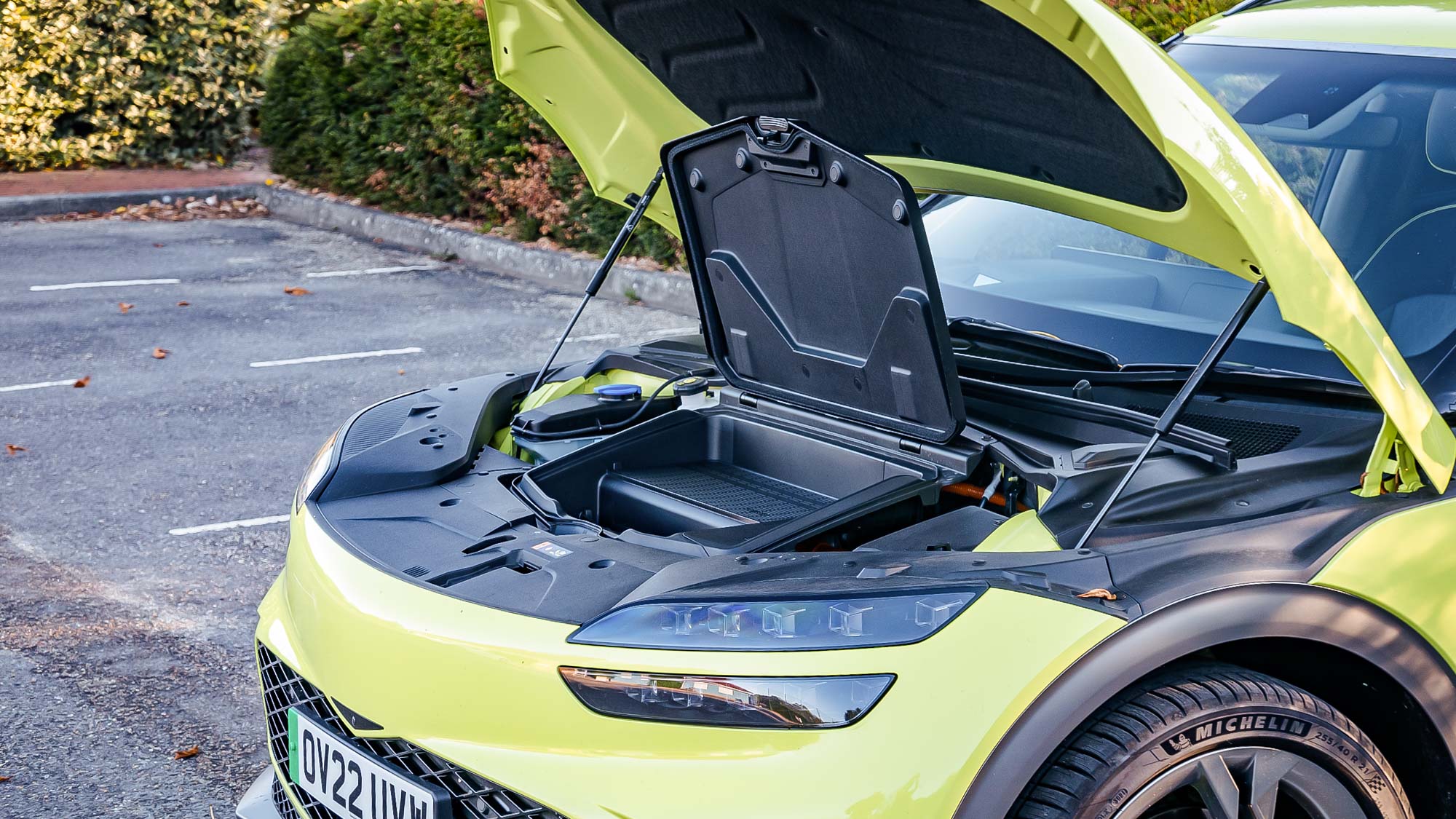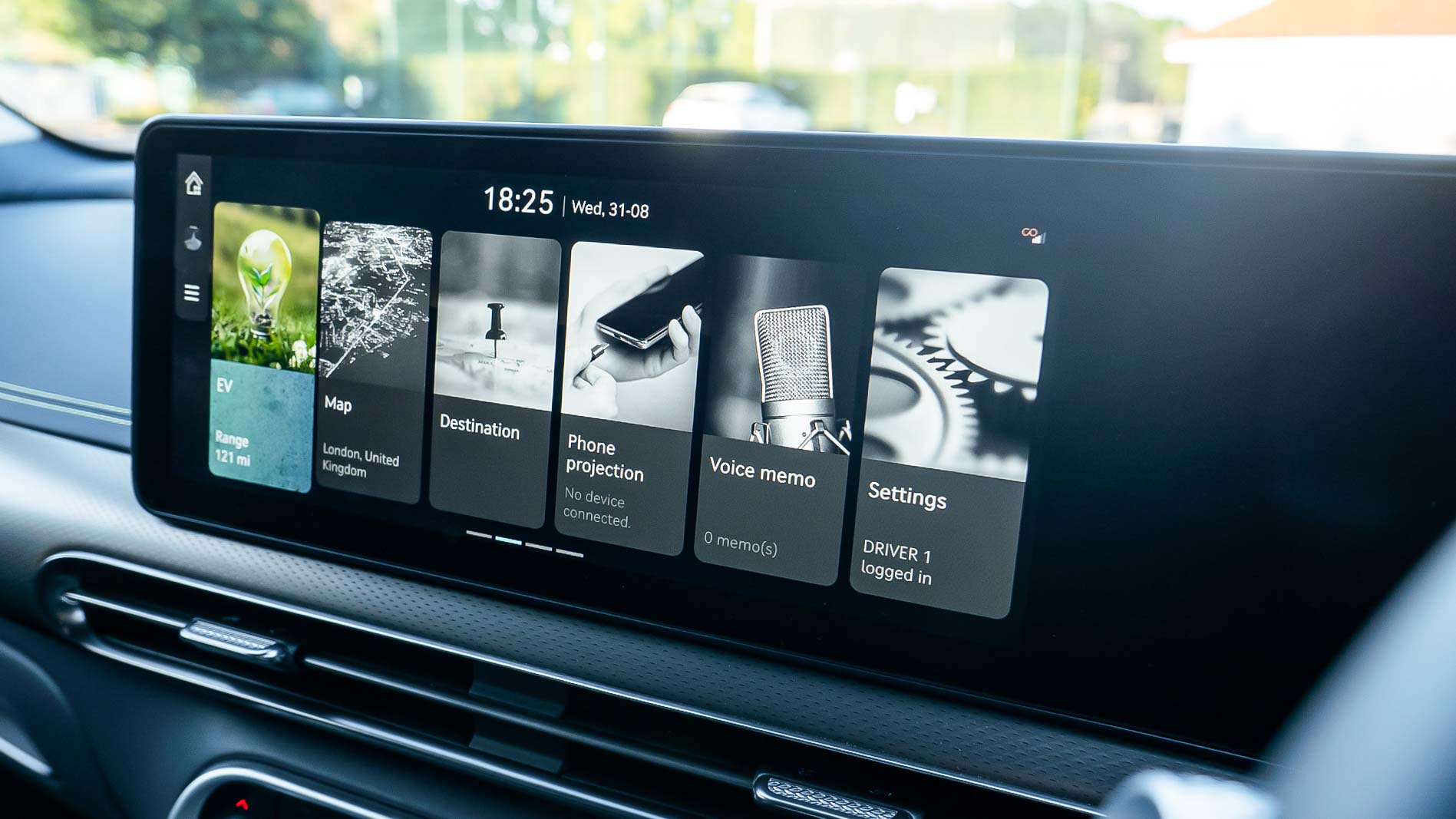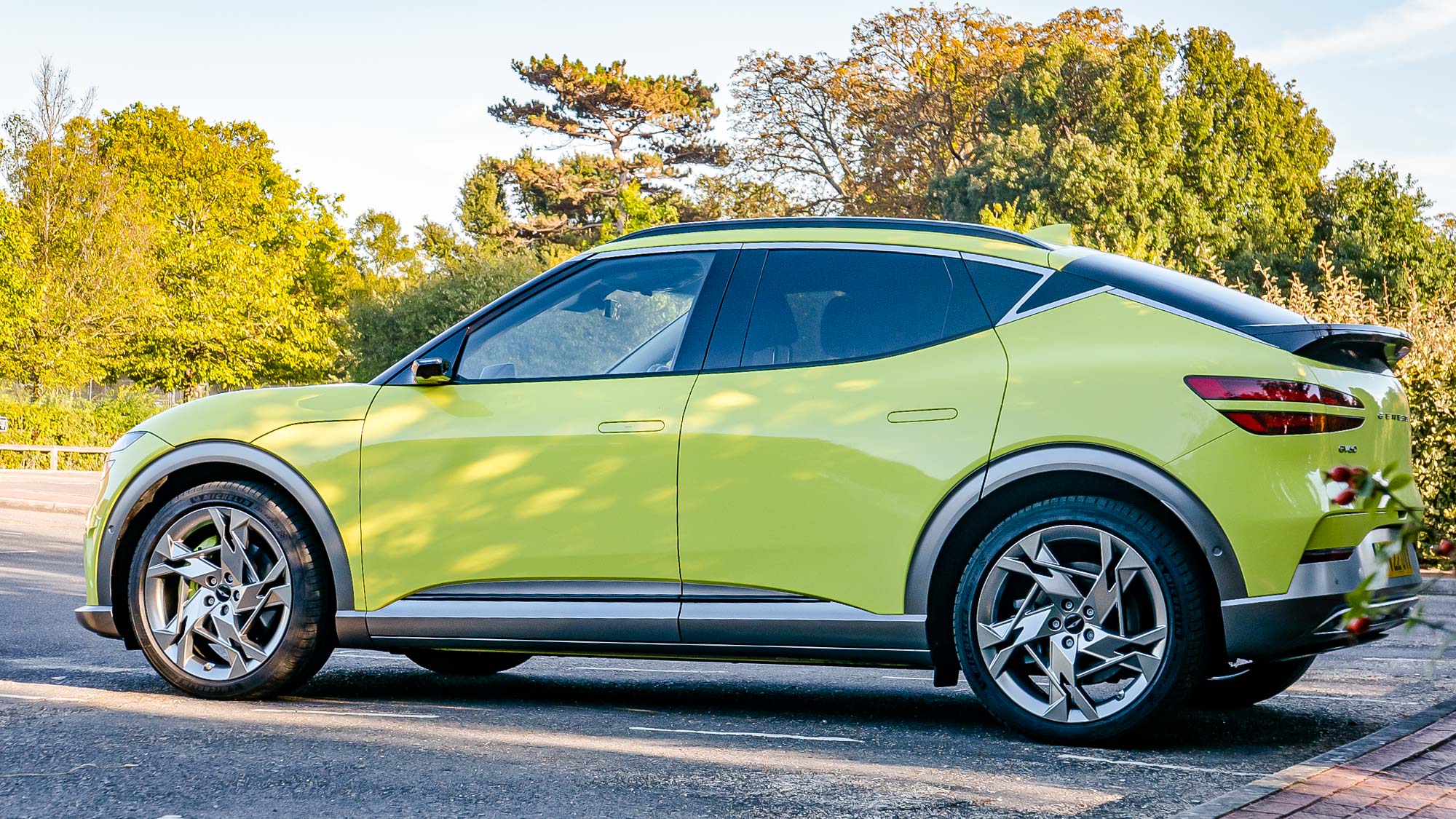Tom's Guide Verdict
The GV60 isn’t just a great first effort for electric cars from Genesis – it’s a fantastic EV, full-stop. The car sits on the same 800-volt architecture as the highly-praised Kia EV6 and Hyundai IONIQ 5, while injecting a healthy dose of impressive styling, loads of technology fitted as standard, and seriously-rapid performance in the appropriate model.
Pros
- +
800-volt system with fast charging
- +
Stylish and unique interior
- +
Rapid performance
- +
Active Noise Canceling sound system
Cons
- -
Can get expensive
- -
Wing cameras aren’t for everyone
- -
Lacks trunk space compared to rivals
Why you can trust Tom's Guide
Release date: Available now in select states
Price: From £47,005 / $58,890 (£75,245 as tested)
Horsepower: 476 hp
Battery range: Up to 248 miles
Charging speed: Up to 350 kW
Top speed: 146 mph
0-60 mph: 3.8 seconds
Smarts: 800v architecture, lane-keep assistant, automatic parking, automatic lane change, choice of augmented engine sounds, active noise canceling sound system
During my week with the Genesis GV60, wide-eyed passers-by asked what on Earth it was on two occasions. A day before it was collected, while sitting in south London traffic, a group of teenage boys stopped in their tracks, declared it a “cool car”, inspected the undoubtedly unfamiliar bonnet badge, and gave me a cheery thumbs-up.
Not the sort of response normally solicited by a fairly small electric SUV, but this is no ordinary car. Not least in the lime green paintwork of my review car, of which only two resided in the U.K. at that time.
Genesis is the luxury brand of the Hyundai Group. So while the company is likely new to almost everyone outside of its South Korea, it isn’t launching into the market with the GV60, its first electric car, from a standing start.
Instead, the GV60 is built on the same E-GMP electric car platform as the Hyundai IONIQ 5 and Kia EV6, which are some of the most impressive (and best value-for-money) EVs currently available.
Sharing the platform means the Genesis has the same motors, 77.4kWh battery and, crucially, the same 800-volt electrical architecture that makes for charging speeds of up to 350W – quicker than the similarly-sized Tesla Model Y, providing you can find an equally rapid charger.
Alongside the Model Y, the GV60 finds itself up against rivals like the Volkswagen ID.4, Ford Mustang Mach-E and Jaguar I-Pace. In a bid to stand apart from its Kia and Hyundai relatives, Genesis is taking the GV60 decidedly upmarket and pitching it as a luxury small SUV.
One that, in the most potent, all-boxes-ticked specification of the example tested here, carries a £75,000 price tag — or just over $85,000. It's worth noting that in the U.S. prices top out at $67,890, since there are significantly fewer optional extras to increase the final price tag.
Get instant access to breaking news, the hottest reviews, great deals and helpful tips.
Is the EV newcomer worth the lofty price tag, or should you stick to the cheaper and more familiar surroundings of its Korean relatives? Read on to find out.
Genesis GV60: Price and availability
The Genesis GV60 is available now. Prices start at $58,890 in the U.S.for the Advanced AWD model, and $67,890 for the Performance variant. The GV60 is also only available in select states right now, including California, New York, Arizona, Connecticut, New Jersey, Nevada, Washington and Utah.
U.K. prices start at $47,005 for a single-motor variant, while dual-motor offerings cost considerably more. There are no regional restrictions, as there are across the Atlantic.
Genesis GV60: Design
Those teenage boys were right to stop and stare. Even without the lime green paint of my test car, the GV60 is a striking machine. Those who really know their cars might spot signs of its being related to the Kia EV6 and Hyundai IONIQ 5, but to all other eyes the Genesis seems truly unique, from the slim quad headlights to the lightning bolt design on the C pillar.

For me, the Genesis is smartly designed; assertive and striking without being fussy and overly complicated. It measures 177.75 inches long, 74.4 inches wide and is 62.2 inches tall. The 15.2 cubic foot rear trunk is fairly compact for a car of this size, more or less matching the related Kia EV6 but falling well short of the 26.5 cubic feet of the Tesla Model Y. For a real world test I found the GV60 swallowed Ikea’s 79.5-inch Billy bookcase with the rear seats down, but only with the box slotting between the front seats and resting on the centre console.

The frunk is really rather small, with just 0.7 cubic feet in the dual-motor car tested here. Anyone who has peered beneath the angular nose of a Kia EV6 will be familiar with this particular shortfall. For comparison, the frunk of a Model Y is a far more useful 4.13 cubic feet.
Genesis GV60: Interior design and features
The interior is where this car really shines. Some of the hard points, like the cantilevered center console floating between the two front seats, are shared with the EV6 and IONIQ 5, but the rest feels totally unique.

The cabin impresses even before you switch the car on, as a transparent glowing orb on the center console illuminates the interior. Turn the Genesis on, and Tony Stark’s paperweight flips over to reveal a gear selector dial.

Strangely, where the Kia EV6 frustrates by using the same touch-sensitive secondary display for media and climate controls, with the inability to show both at once, the Genesis fits a set of physical buttons and toggle switches into the same space. These control for primary infotainment and climate control, framing a dedicated touch panel with haptic feedback for making further climate adjustments, such as fan speed and air flow direction.

This panel is one of the best pieces of car interior design I’ve ever seen. Attractive, intuitive and, crucially, easy to use at a glance — meaning there's no distraction from the road ahead. So too the steering wheel controls, which are actual, tactile buttons and not the frustrating touch-sensitive panels used by the Volkswagen group.

The rest of the dashboard features a pair of 12.3-inch displays, with the centre-most being a touchscreen for tapping and swiping through the infotainment system. Like other Hyundai Group products, the GV60 presents a lot of EV drivetrain and electrical consumption detail for those who want it, but serves up a simple and distraction-free interface while driving.

The integrated mapping system works fine, but most drivers will benefit from plugging in their phone and using Apple CarPlay and Android Auto. The software can be navigated by touch or via a scroll wheel on the center console, further helping to keep your eyes on the road.

An optional extra on my test car was a pair of cameras and displays in place of side mirrors — something that doesn't appear to have made it to the U.S. just yet. As in other cars with this feature, they take some getting used to. Since the interior displays are closer than conventional exterior mirrors, you'll need to tweak your muscle memory when glancing to the side

The cameras can be adjusted like a mirror and automatically switch to a wider angle when reverse gear is selected. Their low-light, nighttime performance was surprisingly good, and after a couple of short drives I felt I’d got used to them. Are they actually any better than conventional mirrors? No, but while it takes getting used to the fact they lack depth of field takes some getting used to I didn’t find myself wishing them away.

Genesis has given the GV60 a lot of technology as standard, including rear parking sensors and camera, which you’ll need to use for every parking maneuver thanks to the sloping roof line and wide C pillars restricting rear visibility.

Overall, the Genesis GV60 has a fantastic interior that boldly stands apart from the crowd, while incorporating attractive and ergonomic design with the sort of fabrics and design details normally reserved for concept cars. I only wish that the many silver-coloured touch points were actually metal instead of plastic, and the door bins were lined with something more premium than scratchy plastic.
Genesis GV60: Driving and performance
There are two drivetrain configurations currently available for the GV60 in the United States. The Advanced AWD offers 314 horsepower with 605Nm of torque, comprised of 255Nm from the front motor and 350Nm at the rear. Meanwhile the performance model offers up to 429 horsepower, with dual 350Nm motors — for a total of 700Nm.

The Performance model is the one you'll want if you want to go fast. When the car is in Sports mode and has the "Boost" button pressed it can reach 60mph in 3.8 seconds and 110mph in 11.5 seconds. The Advanced model makes those distances in a slower, but still impressive, 5.7 and 15.1 seconds.
Unlike most other electric cars, the GV60’s rate of acceleration doesn’t slow above 60 mph, and it arrives at the three-figure mark significantly ahead of similarly-sized rivals like the Ford Mustang Mach-E GT. The top speed is also surprisingly high for an EV, at 146 mph.

This sort of performance is a lot of fun, just as it is in other potent electric cars. But in the real world, the mid-range dual-motor Advanced model will suit most customers. Even the single-motor variant would be an excellent EV for many, should it ever reach the U.S., thanks to a huge amount of kit being available as standard on all three models in other regions.
The rapid acceleration is accompanied by a wide range of sound effects to pick from and personalize. One is meant to sound like an internal combustion engine, while another is what nine-year-olds think spaceships sound like. It’s something to play around with, then maybe show off to your passenger once more, and after that it’ll likely never be used again.

Energy regeneration is adjusted using paddles behind the steering wheel and there are five levels to pick from, ranging from zero, through three numbered levels, to maximum. With the latter engaged, one-pedal driving is possible and the GV60 will come to a complete stop if you lift fully off the accelerator.
Comfort and refinement is generally good, with wind and road noise hushed to a minimum, with partial thanks going to active noise canceling tech in the sound system. The quiet drive is also aided by the GV60 retaining composure over most road surfaces.
The car’s not-insignificant weight does sometimes make itself known over larger bumps at low speed, and its ride isn’t particularly sophisticated, but it is otherwise fine – and noticeably better than the overly firm Tesla Model Y.

Genesis has given the GV60 fairly heavy steering, which becomes even more apparent in sport mode. It’s a sporty touch but doesn’t enhance the way the steering actually communicates messages between the front axle and the driver. Particularly amusing is how the seat tightens its grip on the driver when sport mode is selected, hugging you in preparation for the sort of driving no GV60 owner is ever likely to do.
There’s even a drift mode, which we have previously used on the closely-related Kia EV6 GT. When engaged, the car will quickly step out of line on an artificially wet track, and it’s even possible to maintain a slide if you’re quick on the steering. But this is clearly not for road use – a fact made clear by the complicated button-pressing procedure needed to enable it.
Genesis GV60: Range and charging
Genesis claims up to 248 miles of range for the Advanced GV60, which we think is fairly accurate, and 235 miles on the Performance model. During our week with the car it averaged 3.0kW per mile, which indicates a real-world range of about 230 miles from a charge.
As it uses the same 800-volt architecture as its Kia and Hyundai siblings, the Genesis can be charged far more quickly than some other electric cars. Use a fast enough charger, and you’ll see the battery fill up to a rate of 350kW. If you can find such a speedy charger, you'll be able to top up from 10 to 80 percent in about 20 minutes.
Genesis GV60: Verdict
Genesis has got an awful lot right with the GV60. This is a car that takes the already-proven and widely praised E-GMP platform, and builds upon it an EV that is technically impressive and mixes fantastic design with huge performance, good range, and a balanced approach to new technology.
It’s one of those cars where I’d made up my mind almost immediately. I might not choose the lime green paintwork of this example, but the rest is exactly what I want from an electric car – and, I suspect, what a great many other drivers want too. It was universally admired by those who saw it during my testing, and is a car I would seriously consider buying with my own money.
The rapid performance of the Performance model is largely unnecessary, so unless you really have the desire (and cash) for the quickest, then go for the Advanced model instead. You won’t be disappointed.

Alistair Charlton is a freelance automotive and technology journalist based in London. His work has appeared in Forbes, Wired, T3, CAR Magazine, GearBrain and TechRadar, among others. His specialisms include topics ranging from classic cars and men's lifestyle, to smart home technology, phones, electric cars, autonomy, Swiss watches, and much more besides.

